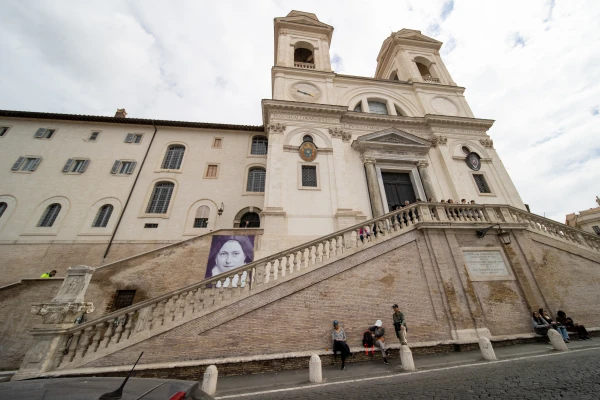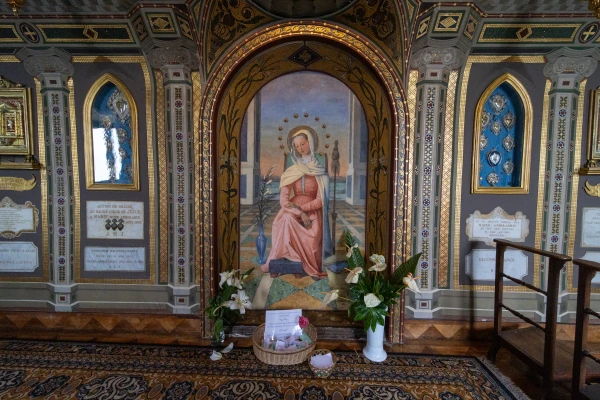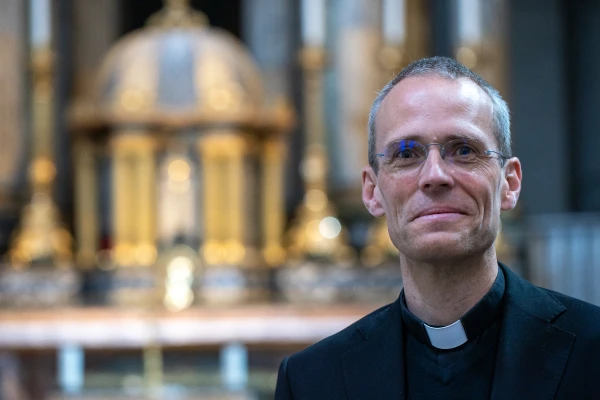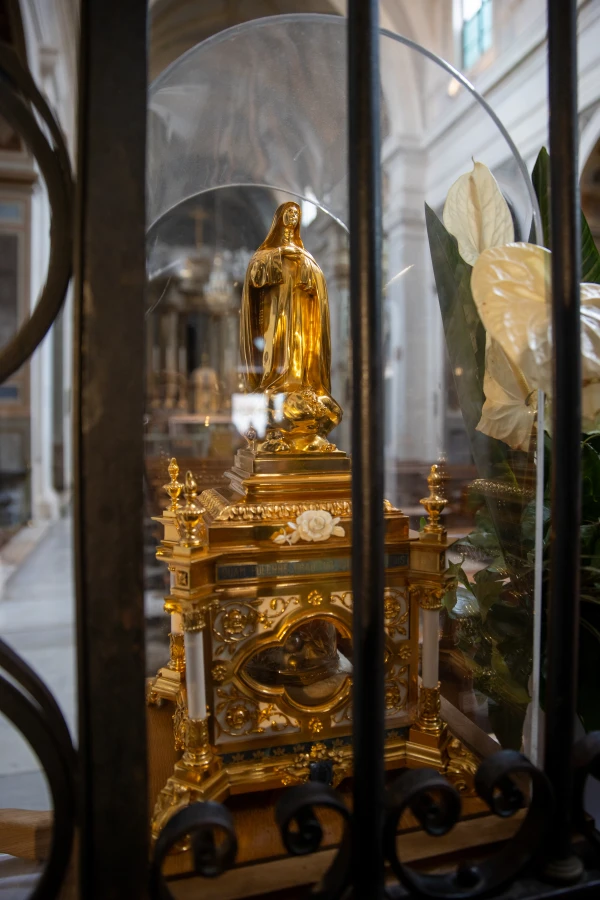Vatican City, May 16, 2025 /
06:00 am
Millions of tourists flock to Rome’s Spanish Steps each year, but few realize that at the top of the steps is a hidden chapel with a special connection to St. Thérèse of Lisieux.
In 1887, during a pilgrimage to Rome, Thérèse Martin — now known around the world as St. Thérèse of Lisieux — visited the chapel of “Mater Admirabilis,” tucked inside a convent atop the iconic staircase.
There, she prayed on her knees before a painting of the Virgin Mary, beseeching God for the grace to enter the Carmelite convent at the age of 15, a request that she also boldly made during an audience with Pope Leo XIII at the Vatican.

This year marks the 100th anniversary of St. Thérèse’s canonization on May 17, 1925. Declared a doctor of the Church in 1997, Thérèse is among the most beloved Catholic saints, known for her “Little Way,” a spirituality of childlike trust and love.
The unique fresco of Our Lady, known by the title “Mater Admirabilis,” is still preserved in the chapel. Today, visitors can access it through the entrance to the Instituto del Sacro Cuore, just to the left of the church of Santissima Trinità dei Monti.

Many graces and miracles associated with the Marian image have been reported over the years, according to Father Fabrice du Hays, rector of Trinità dei Monti.
“We have a ex-voto on the walls everywhere from people who receive graces from this place. And we had a lot of testimonies of people getting healed or getting a special grace,” du Hays told CNA.
In celebration of the Jubilee of Hope, the Trinità dei Monti church is displaying the relics of the saint for public veneration all year and will host the Jubilee of Families at the end of May.
“We are the church for the whole jubilee dedicated to St. Thérèse,” the rector said.
The humble story of the Mater Admirabilis
While the Mater Admirabilis chapel is little known today, it was a “must see” for 19th-century Catholic pilgrims to Rome, according to du Hays.
St. John Bosco offered Mass in the chapel, and Pope Pius XII also visited the image and granted the painting its Marian title, “Mater Admirabilis,” or “Mother Most Admirable.”
The fresco itself had humble beginnings. In 1844, a young postulant of the Society of the Sacred Heart, Pauline Perdrau, was asked to paint an image of the Virgin Mary on the recreation room wall of the sisters’ school. Though she had painted before, she found the fresco technique more difficult than expected.
She portrayed Mary as a young woman in a rose-colored dress. The vivid colors and amateur style led the mother superior to cover the image when it was first completed, calling it “ugly.”
(Story continues below)
Subscribe to our daily newsletter
Weeks later, however, many of the sisters found themselves drawn to the image and referred to it as beautiful, despite its technical flaws.

On Oct. 20, 1846, Pope Pius IX visited the convent and viewed the now-softened fresco. He gave it the title “Mater Admirabilis” and called for the hallway to be turned into a chapel.
The chapel later became associated with several miraculous healings and spiritual graces. The Society of the Sacred Heart adopted the Mater Admirabilis image as a symbol of the Virgin Mary in its global network of schools, including at Catholic schools established in Louisiana and Missouri.
“Students who have been in a Sacred Heart school … have prayed in front of copies of this image. And when they come to Rome, they want to see the original,” du Hays said.
“You cannot imagine the consequences of this painting,” he added.
St. Thérèse and Pope Leo XIII
On Nov. 20, 1887, during her Roman pilgrimage, Thérèse Martin — then just 14 — met Pope Leo XIII at the Vatican to plead her case.
According to her autobiography, “The Story of a Soul,” she kissed the pontiff’s foot, then his hand, before lifting her tear-filled eyes to his.
“Holy Father, I have a great favor to ask you,” she said. “In honor of your jubilee, will you allow me to enter the Carmel when I am 15?”
The vicar general of Bayeux, France, interrupted to say the superiors were reviewing her request.
St. Thérèse recalled that Pope Leo “bent towards me till his face almost touched mine, and his piercing black eyes seemed to read my very soul.”
“Well, my child,” Pope Leo XIII said, “do whatever the superiors decide.”
Thérèse pressed further: “Holy Father, if only you say ‘yes,’ everyone else would agree.”
Leo XIII replied: “Well, well! You will enter if it is God’s will.”
As guards began to move her along, Thérèse clung to the pope’s knee. He placed his hand gently over her lips and then gave his blessing.
“I must admit that in spite of my tears I felt a deep inward peace, for I had made every effort in my power to respond to the appeal of my Divine Master,” Thérèse wrote. “This peace, however, dwelt in the depths of my soul — on the surface all was bitterness; and Jesus was silent — absent it would seem, for nothing revealed that he was there.”
“Rome, where I thought to find comfort and where I found the cross,” she later reflected.
Despite her suffering in the moment, Thérèse went on to enter the Carmel in Lisieux a few months later at the age of 15.
She carried the memories of her Roman pilgrimage with her throughout the rest of her life, recalling in her autobiography her experiences visiting the Colosseum where she kissed “the dust reddened with the blood of the early Christians,” the catacombs where she prayed at what had once been the tomb of St. Cecilia, the Church of St. Agnes in Piazza Navona, and where she venerated the relics of the true cross in Rome’s Basilica of Santa Croce.
St. Thérèse wrote: “Ah, what a journey! It taught me more than the long years of study… I saw beautiful things, contemplated the wonders of art and religion, but most of all, I walked on the very ground of the apostles, a land soaked with the blood of the martyrs, and my soul expanded in contact with holy things.”

The French roots of the Spanish Steps
Despite their name, the Spanish Steps have a distinctly French history. In the 15th century, King Louis XI of France, ill and seeking a cure, asked for St. Francis of Paola, a Calabrian friar, to come to France to heal him.
“When he arrived … he told the king, ‘The Lord sent me to you, not to heal you, but to prepare you to die, and I will help you to die as a Christian,’” du Hays said. The king underwent a conversion before dying and instructed his son to build a convent in Rome for the friar’s order, the Order of the Minims.
That royal wish led to the founding of the French Royal Convent at Monte Pincio in 1495. In 1502, King Louis XII began construction of the Trinità dei Monti church.
Following the French Revolution, the Order of the Minims was forced to leave the Roman church. The Sisters of the Sacred Heart later moved in and opened a school that still operates today.
The famous Spanish Steps “were built by France and they were given back to Rome, to Italy in the 19th century,” du Hays said.
The sisters’ convent school today is still open and includes young students with disabilities among its pupils. “It’s really a place of inclusion,” the rector said.

How to visit the hidden chapel
The Mater Admirabilis chapel can be visited by entering the Instituto del Sacro Cuore, reached via a small staircase to the left of the church entrance at the top of the Spanish Steps.
“The password, if you want to enter in the convent is you go to the entrance door and you say, ‘I want to go to the chapel of Mater,’ and they let you go to pray there,” du Hays said.
“If you want to visit the convent, you have to have a guided tour. But if you want to go just pray in the chapel, it’s always possible during the day.”
Trinità dei Monti is currently entrusted to the Emmanuel Community, a Catholic charismatic movement that seeks to evangelize the throngs of tourists who visit the Spanish Steps.
On Thursday evenings, volunteers invite tourists taking photos on the steps to visit the Trinita de Monti church for prayer, adoration of the Blessed Sacrament, confession, or conversation with a priest from 7:15 p.m. to 8:15 p.m.
“We try to do it as often as possible, and if other missionaries want to join us on a Thursday evening, they are always very welcome,” du Hays said.
English-language Mass is celebrated in the church at the top of the Spanish Steps on Tuesdays at 6:30 p.m., with the opportunity to venerate the relics of St. Thérèse. Eucharistic adoration is held at the church Monday through Thursday from 5:15 p.m. to 6:15 p.m., and Saturday and Sunday from 6:30 p.m. to 7:30 p.m.


















